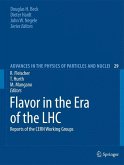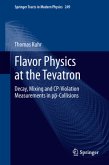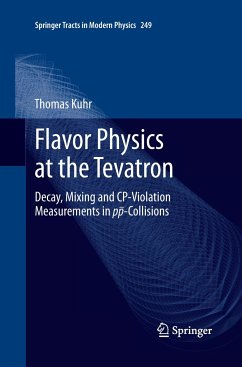The series Advances in the Physics of Particles and Nuclei (APPN) is devoted to the archiving, in printed high-quality book format, of the comprehensive, long shelf-life reviews published in The European Physical Journal A and C. APPN will be of benefit in particular to those librarians and research groups, who have chosen to have only electronic access to these journals. Occasionally, original material in review format and refereed by the series' editorial board will also be included.
The three reviews collected in this volume summarize and document the outcome of the year long work by the CERN working groups studying the role of flavor physics in the era of the LHC. They confirm that flavor physics is an essential element in the future of high-energy physics. Should new-physics particles be produced at the LHC, studies of flavor physics will play a key role, helping to find the underlying new-physics scenario, to study the properties of new-physics particles and to detect or to exclude new sources of CP violation and flavor structures.
a R. Fleischer, T. Hurth, M. L. Mangano Physics Department, CERN, 1211 Geneva, Switzerland In the history of quantum and particle physics, discrete system. In this past decade, the key player has been the B-meson system, and we also witnessed the appearance on symmetries and their violation have played an outstanding + ? rôle. First, the assumption of the conservation of P (parity), stage of the top quark. Thanks to thee e B factories with C (charge conjugation), CP and CPT (T denotes time rever- their detectors BaBar (SLAC) and Belle (KEK), CP vio- tion is now also rmly seen in B-meson decays, where the sal) helped theorists to restrict theoretical predictions, such 0 "golden" decay B ?J/?K shows CP-violating effects as in Fermi's 1934 seminal paper on weak interactions. In S d at the level of 70%. These effects can be translated into the 1957, the observation of P (and C) violation in weak int- angle? of the "unitarity triangle" (UT), which characterizes actions gave a new impact and led to the conjecture that CP the Kobayashi-Maskawa mechanism of CP violation. S- was still a conserved symmetry. In 1963, one year before + ? eral strategies to determine the other angles of the triangle, the surprising observation of CP violation in K ?? ? L ? and ?, have been proposed and successfully applied to decays, the concept of quark- avour mixing was introduced theB-factory data.
The three reviews collected in this volume summarize and document the outcome of the year long work by the CERN working groups studying the role of flavor physics in the era of the LHC. They confirm that flavor physics is an essential element in the future of high-energy physics. Should new-physics particles be produced at the LHC, studies of flavor physics will play a key role, helping to find the underlying new-physics scenario, to study the properties of new-physics particles and to detect or to exclude new sources of CP violation and flavor structures.
a R. Fleischer, T. Hurth, M. L. Mangano Physics Department, CERN, 1211 Geneva, Switzerland In the history of quantum and particle physics, discrete system. In this past decade, the key player has been the B-meson system, and we also witnessed the appearance on symmetries and their violation have played an outstanding + ? rôle. First, the assumption of the conservation of P (parity), stage of the top quark. Thanks to thee e B factories with C (charge conjugation), CP and CPT (T denotes time rever- their detectors BaBar (SLAC) and Belle (KEK), CP vio- tion is now also rmly seen in B-meson decays, where the sal) helped theorists to restrict theoretical predictions, such 0 "golden" decay B ?J/?K shows CP-violating effects as in Fermi's 1934 seminal paper on weak interactions. In S d at the level of 70%. These effects can be translated into the 1957, the observation of P (and C) violation in weak int- angle? of the "unitarity triangle" (UT), which characterizes actions gave a new impact and led to the conjecture that CP the Kobayashi-Maskawa mechanism of CP violation. S- was still a conserved symmetry. In 1963, one year before + ? eral strategies to determine the other angles of the triangle, the surprising observation of CP violation in K ?? ? L ? and ?, have been proposed and successfully applied to decays, the concept of quark- avour mixing was introduced theB-factory data.








